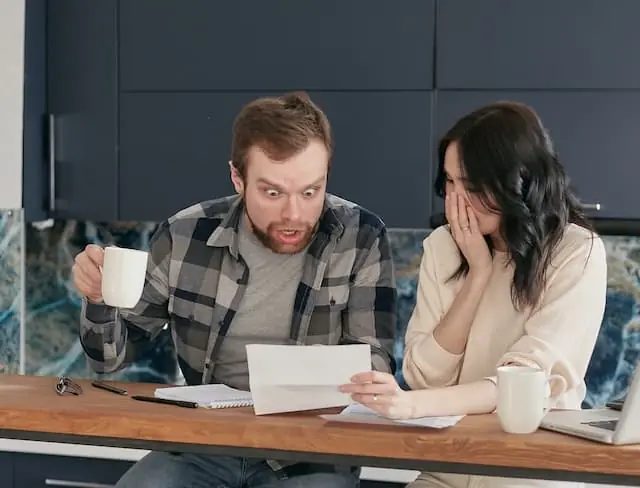If you want to retire early, then you need to know how to invest for early retirement. Simply saving your hard-earned money in the bank and hoping for the best won’t cut it!
Knowing what the best investments are for early retirement is super important. Not just for building your wealth in the first place, but also maintaining your wealth through-out your retirement.
But it doesn’t need to be difficult! In fact, it should be simple, straight forward and (crazy as it sounds) boring.
I always found the more we could make things automated, and ‘stress-free’, the more things just seemed to work. The more we complicated things, the more we would stress, and our results went backward.
The following is a summary of the investments we used to create our wealth and retire early (before 50).
So let’s get started!
But First the All Important Disclaimer!
Let’s make this simple. Nothing I say here is meant to be financial advice of any description. Whatever worked for me, may not work for someone else.
I am simply sharing my experience and what I’ve learned on my own journey. Any links or information I refer to are provided as information only and should not be taken as professional advice.
What I hope to do is share an experience of how I personally managed to achieve something very few people can do. There just maybe some little snippets of what I did that spark something in your thinking.
You should always do your own research when making financial decisions and if you require, seek out professional advice.
How To Retire Early – 30 Seconds Summary
Here is a quick recap on how to retire early;
- Reduce your spending – know where your money is going and “stop the leakage”.
- Increase your income if possible – ask for a raise/promotion, get a side-hustle.
- Use this to increase the ‘gap’ between your income (cash in), and your expenses (cash out).
- Use this positive ‘gap’ as your investment cash, to invest in simple long-term investments that return 6-10% pa on average.
- Have faith in the process, stick to the strategy and DO NOT be distracted by promises of ‘getting rich quick’.
That’s it! Do not allow yourself to get lost in all the detail, especially as your wealth knowledge grows. Believe me it is so easy to get lost and distracted along the way.
Check here to find out more about the process of how to retire early, and how we achieved it so young.
The Importance of Investing Early
Right from the start of earning a wage, my wife and I saved around 20% of what we earned. As our income grew over time this amount grew as well.
It was probably more than 20% as my wife had a habit of squirrelling money away before I even knew.
We had a house-hold budget and that included the savings. So, if we needed money for something or found ourselves a little short one month, we knew what we could cut back on.

And it was NEVER our savings!
Then we started investing what we had saved. It was a bit random at first and over the years we have made some really stupid mistakes and lost thousands!
But even with the mistakes we made, the fact that we started so early meant we had time on our side. The years marched on, and our wealth continued to grow.
Not only that but as the compounding effect kicked in, things really took off. Before we knew it, we could retire!
Investing – Keep it Simple
Ok, so you’ve got your strategy all sorted and you now know the steps to building your wealth. But where do you put your savings to hit your wealth goals? What are the best investments for early retirement?
As I said above, this is not meant as investment advice. I am not going to suggest any particular investment vehicle, stocks or property, to invest in. All I can do is let you know what we did.
You should do your own research and seek out your own financial advice, tailored to your circumstances.
While most of our wealth came from property investment, more recently we have been shifting our money back into shares. This asset shift is to prepare for moving our superannuation retirement fund into ‘pension mode’ (see below for more details).
Reflecting back, and seeing the alternative investments now available, I would now do things differently. There are now much easier ways to get exposure to the property market than direct property ownership.
The one thing I want to stress is to keep it simple. It was always the simpler approach that worked for us. When we added complexity, we always came unstuck.
So, let’s get into some details.
Is It Worth Investing In Property
When we started our investment journey it felt like the investment world was divided into those that believe in property and those that believed in the stock market. However, we wanted to take a slightly more ‘balanced’ approach, so worked on understanding both property and stocks.

Right now, if you are in most Australian capital cities and listen to the media, you wouldn’t touch property with a barge pole! Bank interest rates rising, and uncertainty in property prices making investing in realestate feel very risky.
Traditionally, property investment was considered very stable and safe. There was a saying in Australia the if something was considered very low risk it was said to be, ‘safe as houses’.
Typically, the value of property doubled every 7-10 years. If you could get yourself into the property market, in around 8 years your investment had at least doubled.
This is why we started our investment journey with property. We had purchased our own home (with the help of a reasonable mortgage) and decided to buy our first investment property.
This simple decision made a huge difference to our wealth creation.
Side note: looking back it is simple decisions like this made at a moment in time that often make all the difference. The moment when we could have thought, let’s go on a holiday instead, or buy a new car. But instead purchased an asset that shaped our future.
We then went on to purchase several more investment properties, which ultimately formed the bulk of our wealth portfolio. Then we simply let time do its magic.
We kept it simple and focused on smaller ‘villa’ style units, closer to the CBD, that were easy to rent.
However, I do think a little luck was on our side. We did this at a time when investing in real-estate was a great option. The market conditions were just right, and our portfolio grew nicely.
Now I’m not so sure. At least here in Australia the property market has been a little harder to navigate. It now requires more research and knowledge to get the necessary returns.
Benefits of Property Investment
The beauty of real-estate investing is that you can leverage yourself into it – meaning you only need a smaller deposit to ‘control’ a larger amount of capital.
Let’s say you are looking to buy a $500k investment property. This means you would need $100k as a 20% deposit. So, for $100k you are now receiving the growth on $500k.
If the property grows at 10% you now have $50k in capital growth, instead of just $10k (10% of the deposit amount $100k).
You have ‘leveraged’ your money invested by 5 times. Not bad!

Then if you use the equity you have in an existing property (like you own home) for the deposit, you have not needed to come up with the $100k cash deposit to start.
You can see how a very healthy portfolio can be created, leveraging one property into the next. This is how we slowly built up our property investments.
Downside of Property Investment
The leveraging of your money into property also has a downside. The leveraging effect works both ways, up and down.
This means a greater exposure if the market drops. If the market drops by 10% then you have effectively lost half of your original $100k investment (eg 10% down on your $500k property is $50k loss).
This is why the purchase price of the property is so important. You make the most amount of the capital growth in the purchase price, not the sale. Pay too much up front and you will always be playing catchup for a reasonable profit.
Also, when you decide to own an investment property you need to understand that you are providing a service to the community. To make the investment work you will want someone to rent it from you.
You need to remember that you are providing someone somewhere to live!
This is a key point that is often overlooked. Unfortunately, here in Australia there is a love-hate relationship between property owners and tenants (mostly hate if you listen to the media).

This whole thing of dealing with tenant issues can be a huge pain. And it also brings a lot of hidden costs that add up. There are always things to repair, and things being broken.
Often the return you are expecting isn’t as good as hoped. Certainly, the pure cash flow usually isn’t very good. So, you are often relying on capital growth of the property for your real wealth creation.
Then add to this the uncertainty around things like negative gearing (using tax breaks to assist with the cash flow issue) and removing discounts on capital gains tax, and the whole thing gets messy.
You can see why many people are turning away from direct property investment – hence a growing lack of rental properties, but that is another story!
Things to Consider When Investing in Property
Everything considered, I still believe property to be a great wealth creation vehicle. But I also know that it does require more research and investigation to make sure you eliminate as much risk as possible.
The key things for you to consider are;
- You make the most profit at purchase. You have more control at the time of purchase then when you sell. You can choose what you pay or not for a property, but the ‘market’ chooses what a property is worth at sale.
- Always look to the longer term. It was time that really made the difference to our capital (wealth) growth.
- Always keep your risk low. Lock in lower interest rates where possible, and do not over-gear yourself. There is no harm in putting in a higher deposit to keep your mortgage lower and more manageable.
- Always assume the worst in the future. Yes, interest rates will rise at some point. Make sure you have enough cash flow/income to cover it!
Property Investing – Find Out More
To find out more about investing in real-estate checkout these sites;
and this article, 8 steps to getting started in property investment.
Investing In Shares and the Stock Market
Let’s get something clear right up front. Our wealth creation using shares was 100% through a longer term, buy and hold process.
Yes, I dabbled in some short-term share trading, but it never came to anything. And never provided the level of return we wanted.
We started investing in solid ‘blue chip’ stocks to start. My wife purchased a copy of an annual public company results book and went through every page. She highlighted all the stocks that met a certain criteria so we could identify good long term buying opportunities.
This was 30 years ago, before specialist software and the internet made the process so much easier!

The Australian Stock Market has consistently grown by 8-10% pa averaged over the past 100 years, regardless of external factors.
But the objective was still the same; find companies that had solid results, growing steadily over time with few surprises. As a mentor of ours pointed out these were usually the dull boring companies, that sold simple everyday items we all use.
This is an interesting point. If you made a list of the places you buy from regularly, and bought shares in just those companies, you would already have a very solid long-term portfolio.
It doesn’t need to be hard. There is a lot to be said for keeping things simple and taking advantage of what is right in front of us!
Index Fund and Exchange Traded Funds
What changed the most for us was discovering Index Funds and later Exchange Traded Funds. These two investment tools make investing in various markets super easy.
No longer did we have to work out which company stocks met our investment criteria, or how to get the right ‘coverage’ in the market. This could now be largely automated.
What are Index Funds and ETF’s?
Index Funds are simply ‘managed funds’ that are made up of the stocks in a particular market ‘index’.
Take the Australian ASX200 index, which is the top 200 stocks in the Australian Stock Market. There is an index fund that simply mirrors this exactly with the same stocks, weighted in the same way as the index.
As the index changes over time, the fund makes the same changes to align to the index. Stocks drop in and out of the index, and their ‘weighting’ changes. So, the fund buys and sells the underlying stocks to maintain the same balance.
This is all done for you, behind the scenes. We don’t need to do anything to keep the same coverage, balance and diversity in our portfolio.
Exchange Traded Funds (ETF’s) are very similar in that they represent a segment of a market, but they are also traded on the stock exchange. So just like buying stocks in an individual company, you buy stocks in an ETF and gain exposure to a whole market segment.
There are now ETFs for almost any key industry, or market segment you may wish to invest in.
This includes property, which is why I believe this may be a better way to include property in your portfolio without having the hassles of owning it directly.
We found using these tools correctly reduced our risk and stress, while still giving us the level of diversity we wanted.
Key Benefits of Index Funds & ETF’s
One of the key lessons we learnt early on was that it was very difficult to beat the market index. There are volumes of articles being written about this, much to the dismay of fund managers stock traders.
In fact, most active funds, meaning they take some active approach to buying and selling stocks, struggle to beat the index over the long term. Yes, there are times where they get it right and out-perform, but these are countered by times of underperformance.

Then when you consider the fees to operate these funds, it results in overall lower return.
Once we understood how Index Funds and Exchange Traded Funds worked it was like a weight was lifted off our shoulders!
We didn’t need to do the research into which stocks were the most likely to do well, or worry about the best time to buy or sell. We simple bought units in an Index fund and let time take care of the growth.
That has been our strategy ever since.
We started using Vanguard Index Funds, focusing on the Australian ‘All Ords’ Index. Later we included a Property Index Fund for diversity, focusing on commercial properties in Australia.
Vanguard is one of the largest fund managers in the world, proving this simple lost cost, low ‘effort’ approach is incredibly popular.
Now there is a huge range of options available, from a range of providers, including Exchange Traded Funds. ETFs allow you to invest in a range of countries and industries, bringing good diversity into your portfolio.
If you are still keen to have some Property in your portfolio, there are several index funds and/or ETFs that can take care of that. So, you can have exposure to property industry, without the headaches of managing the actual property.
There are even ETFs and similar tools available to access investments such as commodities (gold etc), and Government Bonds. You can create a well-balanced, diverse portfolio purely with Index Funds and ETFs.
The beauty of Index Funds and ETFs are the fact that they are low cost (have very low management fees) and provide simple access to a broad range of markets.
Index Funds & ETF’s – Find Out More
To find out more about this approach, check out the Vanguard website here. Also, you can check out these guys, StockSpot. They have some great articles on the benefits of index and ETF investments.
Investments to Avoid for Retirement
My wife and I have always been conservative by nature, particularly when it comes to our investment strategy. We never invested any money in anything like cars, art, stamps, or more recently things like crypto.

In fact, any time we stepped outside our simple investment approach we usually came unstuck.
Believe me, you will be tempted by many ‘alternative’ investments. You will be told that making money has changed and that this is the ‘new thing,’ the new way to make money – and simply everyone is doing it!
Don’t be distracted. Keep it simple, lower risk and importantly low stress.
Here’s a quick list of things I would avoid.
‘Exotic’ Investments
So many things from art to cars, collectables and even sports memorabilia can make money. But that doesn’t make them good investments for your retirement.
Avoid the Latest Trend
Most ‘trends’ are just that; a short, often explosive growth cycle, followed by a crash as the crowd moves to the next trend.
Get Rich Quick Schemes
There is no such thing as getting rich quick! These are simply someone’s way of tapping into human greed to make money for themselves. Don’t fall into their trap!
Crypto-currencies
Don’t get me wrong, I think that crypto currency is the future of world currencies. But that is exactly what they are – a currency. Buying crypto coins is no different than say buying Euro’s, or US dollars expecting them to go up.
Non-Fungible Tokens (NFT’s) – Special Level of Crazy!

Run as fast as you can from made-up ‘investments’ like these! They fall into the category of ‘the greater fool’ theory of investing. In other words, you only make money if there is a bigger fool who is willing to pay more for it than you did.
I personally believe this type of speculative ‘investments’ should only be ‘tested’ once you have your ‘main’ investment strategy on auto pilot. And you should only invest money you are prepared to lose. Just ask anyone who jumped into crypto late. 😳
My sister asked me if I had invested in crypto, and I said “nope, I like to keep my money!”.
Superannuation – How Does It Factor into Early Retirement?
In Australia we have a compulsory Superannuation scheme. Most western nations have something similar. In the US it is referred to as an Individual Retirement Account (IRA), or 401k, for example.
I strongly suggest you take the time to research and understand what the local retirement savings scheme is for you and how it works.

The funny thing with early retirement and Superannuation is that the earlier you reach retirement, superannuation takes on a much different meaning.
If you retire before age 60 then you can’t access any funds in your superannuation. So, you will need to have funds outside of superannuation to live off.
If you manage to retire really early, say in your 40’s, then it’s hard to understand where superannuation fits in your overall plan – especially when you can’t access it for 10-20 years!
Why would you put money into a fund you can’t touch when you will need that money to live off?
But having said all that, there are significant reasons why you would and should take the time to understand Superannuation (or your regional equivalent).
Here in Australia, there are significant tax benefits from investing into superannuation.
For example, you can make what is known as ‘concessional contributions’ that reduce your taxable income (eg from your salary). Anything that you earn from your investments is typically taxed at a lower rate, than outside superannuation.
Also, once you put your superannuation fund into ‘pension mode’ there is a significant amount that is tax free. At the time of writing this is capped at $1.7m, meaning any interest earned from that $1.7m is completely tax free.
To put that into real terms, $1.7m invested earning say 5% pa would give you $85k each year (on average).
Again, you need to do your own research on this to understand the rules around retirement funds in your region/country. In Australia, the government run Moneysmart website is a great place to start.
You should also seek out a professional to help with this and provide advice on your specific situation.
The message is to not ignore it or sleep on it – there is gold there to be had that can make a significant difference to your retirement wealth and income!
How to Invest to Retire Early – 5 Key Takeaways
We have covered a lot, so let me quickly summarise. Here are my 5 key takeaways for investing to retire early.
- Start investing as early as you can. $1 invested at age 30 is worth at least $5 by 65.
- Keep things simple and think long term. The more automated and stress free your investing is means it is more likely you will stick with it.
- Balance your investment portfolio across two more market types. For example, Australian share and property.
- Consider using Index Funds and ETF’s to gain exposure to multiple markets and industries. Great for balancing your portfolio.
- Make sure you understand superannuation or retirement funds. They can be amazing tools for building wealth in a reduced tax environment.
That’s it. Don’t over complicate things and never stop learning about money. The more you can increase your ‘wealth knowledge’ the better you will be in the future.
And remember this;
Time will come and go, but the difference between where you are today and the future you wish for is the steps you take now!
Please let me know your thoughts below, or if there is something you would like to know more about.
Until next time,




Leave a Reply